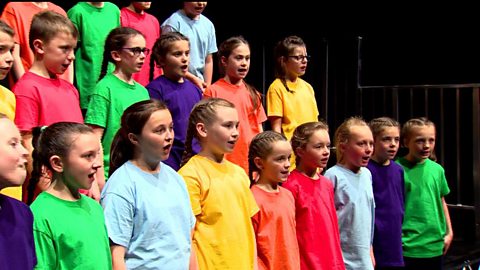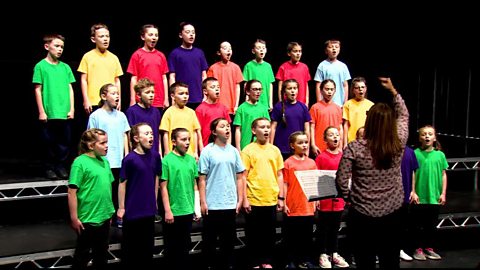
Musical phrasing is like telling a story. When you speak, you might emphasise particular words or speed up and slow down to make the story sound more interesting - musical phrasing lets you do the same thing when singing.
Deciding when to breathe, how fast or slow you sing or which words to emphasise are all part of musical phrasing.
All of these things can help you communicate the meaning of the song and create a certain 'feeling' or emotion.
Composers often write musical terms on music to help guide phrasing and help you to understand how they want it to sound. These words are normally written in Italian.
By changing your phrasing you can really alter the feeling of a song.
In this film our choir adds phrasing in incorrect places and then sings it with the right emphasis. Listen to how it changes the flow of the song:

Often, a choir will use тdВтВдВЙГООБГІВѕт in their sound by adding more or less volume or intensity to a phrase.
For example, singing тpОБВЙВдДЧт is when you sing quietly and use your breath to support the sound.
тFДЧАљГйБ№т is the opposite of piano. It is when you sing loudly, making sure not to push your voice too much.
Another term you might see is тlБ№ВЕВЙГйДЧт. It is the Italian word for тtied togetherт and means the phrase rolls on smoothly.
тSГйВЙГІГІВЙГйДЧт is the opposite. Itтs the Italian word for тdБ№ГйВЙГІГѓБ№Лхт. This is when the notes are short and have lots of space between them.
In the next video, our choir sings legato in the first verse and staccato in the second verse.
Can you hear the difference?
Phrasing can also mean the volume youтre singing at.
A crescendo is when you sing a phrase that gradually gets louder and a diminuendo is the opposite, itтs when your singing gets quieter through the phrase.
Here are some examples:
When singing crescendo or diminuendo, you need to breathe deeply to carry enough energy though to the last note.

More on Music
Find out more by working through a topic
- count4 of 20

- count5 of 20

- count6 of 20

- count7 of 20
